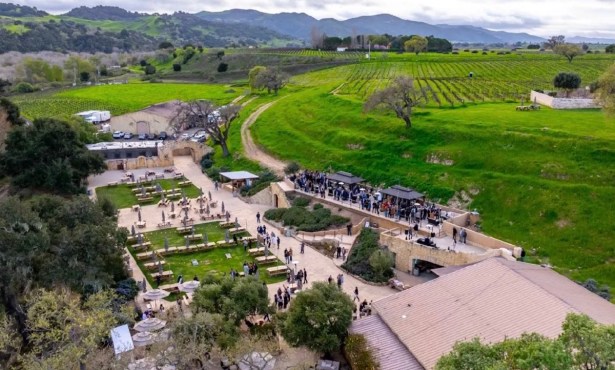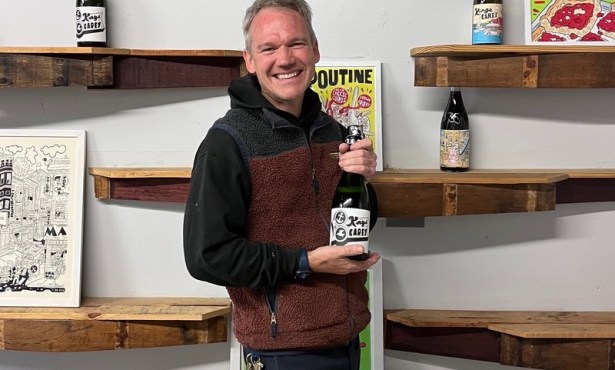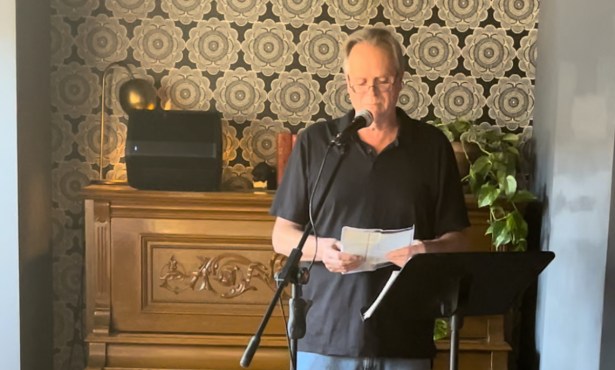Santa Barbara County Wine Legends for Sale
Longoria Wines Seeks to Sell It All, While Ampelos Cellars Offloading Vineyard, Not Brand

The wine industry welcomes all sorts of origin stories, which grow increasingly diverse with time. But in the case of Santa Barbara County, two narrative arcs dominate: that of the pioneering visionary who started in the early days and evolved into an iconic vintner, and that of the soulful shapeshifter who ditches corporate life to become a hands-on artisan, using proceeds from a past career to fuel passions of the next.
No matter the first lines of these stories, though, there comes a time for the last chapters to be plotted, and that’s where we pick up with two legendary teams of the Santa Ynez Valley: Richard and Diana Longoria of Longoria Wines, who epitomize the pioneer saga, and Peter and Rebecca Work of Ampelos Cellars, whose shift from suits and spreadsheets to cowboy hats and forklifts is as authentic as it gets. As these couples eye what retirement might look like, both brands are now looking to cash out, but in distinct ways.
Get the top stories in your inbox by signing up for our daily newsletter, Indy Today.
Longoria: Everything on Table
For the Longorias, the goal is selling everything: their brand, their winery and tasting room in Lompoc, and access to the grape contracts, including possibly Fe Ciega Vineyard, which Longoria planted in a sweet spot of the Sta. Rita Hills — all for $2.5 million. They started thinking about this move a couple years ago, and now — with three grandchildren and Rick hitting 70 years old in March 2021 — the time felt right.
“It’s just the two of us,” said Rick recently. “Diana handled the core of the business — the accounting, the employees, the wine club. That’s easily two-thirds of any winery business in terms of work and headaches. And I get the fun of making wine. She’s more than ready to hang that up.”
Unlike wineries that turn multigenerational, there are no Longorias waiting in the wings to take over. Their daughter is established in Salt Lake City, where her husband is a respected brewer, and their son has built a career in drilling wells across Santa Barbara County. “He’s seen every bit of this since he was a kid,” said Longoria. “The winemaking part would appeal to him, but not the business part.”
That aspect only grows tougher each year. “It’s gotten ever more competitive,” said Longoria, who was lucky to start in the late 1970s, when the region was brand-new. “It’s always an advantage to be up-and-coming. You want to be the new kid on the block with the latest flavors. Ironically enough, all these years of experience never made it easier.”
Since putting the winery on the market in January, the Longorias have received a few serious inquiries, in part due to urban dwellers’ increasing interest in smaller towns. “This whole COVID thing has put a different perspective on people’s lives and where they live,” said Longoria, though he knows it may take a few years to ink a deal. “We’re not super anxious. We know it may take some time.”
In preparation for this stage, he’s been shrinking production over time, down to about 1,600 cases last year from an average closer to 3,000. The 4,000-square-foot production facility can handle at least that, and the sale comes with a finalized permit that would allow the winery to double in size.
Longoria hopes to stay in the business in some capacity, either as a consultant for the new owners or even for other brands. “For Diana, this was an easy decision,” said Longoria. “For me, I still enjoy making the wine and I’m relatively still in good physical condition. So I might be able to sneak a couple hundred cases here and there. It’s all I’ve done since I was 23 and I still enjoy it.”

Ampelos: Just the Ranch
At Ampelos Cellars, the Works are explicitly seeking to stay in the business long-term. They are selling their 82-acre ranch — which comes with a 25-acre vineyard in the eastern Sta. Rita Hills, a home with epic views, and all the farming equipment for $6.5 million — in order to do so.
“We are looking at what we want to do with the next phase of our lives: What is fun and what is not quite as fun?” said Peter Work, who left corporate life after a near-brush with the 9/11 attacks to develop the first vineyard in the United States to be simultaneously certified as organic, biodynamic, and sustainable. “We like making wine. It’s a fun, creative process. But we have a premiere vineyard, and I feel that I’ve done as good as I can when it comes to farming. I don’t think it could get much better.”
He enjoys collaborating with folks — such as the actor Kurt Russell, the American-in-Burgundy Alex Gambal, and myself (I’ve made barrels of noncommercial wine at Ampelos since 2012) — and exploring experimental batches, like the piquette and orange wines he is pursuing this vintage. But making upward of 9,000 cases, as they’ve done in the past? “It’s exhausting,” said Work, who’d prefer to scale down to 2,500 cases annually. “We want to make less wine but do more fun projects.”
Plus, the farming duties that once sparked pride of ownership — like getting up at 6 a.m. on a Sunday to fix PVC pipes when the faucets don’t run — aren’t so shiny anymore. “It’s just no longer as exciting as it used to be,” said Work, whose vineyard is about two-thirds pinot noir, with the remainder a mix of syrah, grenache, viognier, and riesling.
He sees two potential buyer profiles: one, a couple like what he and Rebecca were 20 years ago — in love with the area, successful in business, and looking to get away from big-city craziness but still have a day job focused on building a sustainability-minded brand. (And the Works would lend all their farming, regulatory, and economic expertise toward making that happen, if desired.) The other would be an existing brand that wants a “jumpstart” into the organic and biodynamic realm. There’s also room on the property for a winery and tasting room, very close to Highway 246.
What’s not on the table for either of these offers from Longoria or Ampelos? Regrets of any sort.
“It has been an incredible journey,” said Work. “For the past 20 years, we have been doing this, building everything from scratch. It has been an amazing chapter in our life.”
Every day, the staff of the Santa Barbara Independent works hard to sort out truth from rumor and keep you informed of what’s happening across the entire Santa Barbara community. Now there’s a way to directly enable these efforts. Support the Independent by making a direct contribution or with a subscription to Indy+.




You must be logged in to post a comment.